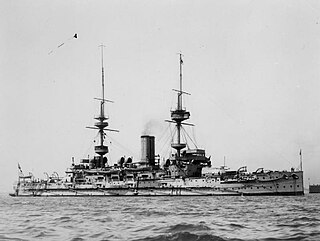
Hawaii (CB-3) was intended to be the third member of the Alaska-class large cruisers. It was the first United States Navy ship to be named after the-then Territory of Hawaii. Because Hawaii's construction was delayed by higher-priority ships like aircraft carriers, its keel was not laid until December 1943, about two years after its sister ship Guam.
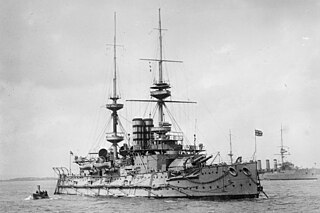
The Majestic class of nine pre-dreadnought battleships were built for the Royal Navy in the mid-1890s under the Spencer Programme, named after the First Lord of the Admiralty, John Poyntz Spencer. With nine units commissioned, they were the most numerous class of battleships in history. The nine ships, HMS Majestic, Caesar, Hannibal, Illustrious, Jupiter, Magnificent, Mars, Prince George, and Victorious, were built between 1894 and 1898 as part of a programme to strengthen the Royal Navy versus its two traditional rivals, France and Russia. This continued the naval re-armament initiatives begun by the Naval Defence Act 1889.
The Admiralty Pier Turret or Dover Turret, is an enclosed armoured turret built in 1882 on the western breakwater of Dover Harbour in southeast England. It contains two Fraser RML 16 inch 80 ton guns, the biggest installed in the United Kingdom. Declared obsolete in 1902, it is currently part of the port and inaccessible, though the guns remain in place.

Barbettes are several types of gun emplacement in terrestrial fortifications or on naval ships.

Jean Bart was a French battleship of World War II, named for the 17th-century seaman, privateer, and corsair Jean Bart. She was the second Richelieu-class battleship. Derived from the Dunkerque class, Jean Bart were designed to fight the new battleships of the Italian Navy. Their speed, shielding, armament, and overall technology were state of the art, but they had a rather unusual main battery armament arrangement, with two 4-gun turrets forward and none aft.

HMS Gorgon and her sister ship Glatton were two monitors originally built as coastal defence ships for the Royal Norwegian Navy, as HNoMS Nidaros and Bjørgvin respectively, by Armstrong Whitworth at Elswick. She was purchased from Norway at the beginning of the First World War, but was not completed until 1918 although she had been launched over three years earlier. She engaged targets in Occupied Flanders for the last several months of the war and fired the last shots of the war against such targets on 15 October 1918. She was used as a target ship after several attempts to sell her had fallen through before being sold for scrap in 1928.
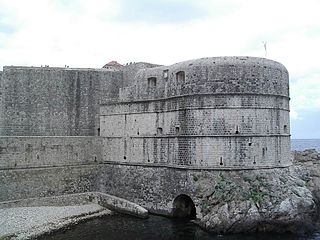
A casemate is a fortified gun emplacement or armored structure from which guns are fired. Originally, the term referred to a vaulted chamber in a fortress. In armoured fighting vehicles that do not have a turret for the main gun, the structure that accommodates the gun is termed the casemate.

A gun turret is a location from which weapons can be fired that affords protection, visibility, and some cone of fire. A modern gun turret is generally a weapon mount that houses the crew or mechanism of a projectile-firing weapon and at the same time lets the weapon be aimed and fired in some degree of azimuth and elevation.

The Tordenskjold class of coastal defence ships was ordered by Norway as part as the general rearmament in the time leading up to the events in 1905 - when Norway broke out of the union with Sweden - the two ships in the class remained the backbone of the Royal Norwegian Navy until they were considered 'unfit for war' in the mid-1930s.
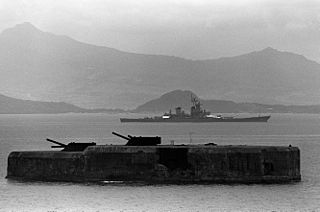
Fort Drum, also known as "the concrete battleship", is a heavily fortified island situated at the mouth of Manila Bay in the Philippines, due south of Corregidor Island. The reinforced concrete sea fort shaped like a battleship was built by the United States in 1909 as one of the harbor defenses at the wider South Channel entrance to the bay during the American colonial period. It was unique among forts built by the United States between the Civil War and early World War II, both as a sea fort and in having turrets. It was captured and occupied by the Japanese during World War II, and was recaptured by the U.S. after igniting petroleum and gasoline in the fort, leaving it permanently out of commission. 68 Japanese soldiers perished in the blaze. It took the U.S. soldiers days before they could even go into the fortress because of the heat.

The dreadnought was the predominant type of battleship in the early 20th century. The first of its kind, the Royal Navy's HMS Dreadnought, made such a strong impression on people's minds when launched in 1906 that similar battleships built subsequently were referred to generically as "dreadnoughts", and earlier battleships became known as "pre-dreadnoughts". Dreadnought's design had two revolutionary features: an "all-big-gun" armament scheme, with more heavy-calibre guns than previous ships, and steam turbine propulsion. As dreadnoughts became a symbol of national power, the arrival of these new warships was a crucial catalyst in the intensifying naval arms race between the United Kingdom and Germany. With the launch of a single ship, Dreadnought, the scales of naval power were reset overnight. As a result, dreadnought races sprang up around the world, including in South America, during the lead up to World War I. Successive designs increased rapidly in size and made use of improvements in armament, armour, and propulsion throughout the dreadnought era. Within five years, new battleships had outclassed Dreadnought. These more powerful vessels were known as "super-dreadnoughts". Most of the original dreadnoughts were scrapped after the end of World War I under the terms of the Washington Naval Treaty, but many of the newer super-dreadnoughts continued to be used throughout World War II. The only surviving dreadnought is USS Texas, located near the San Jacinto Battleground State Historic Site.
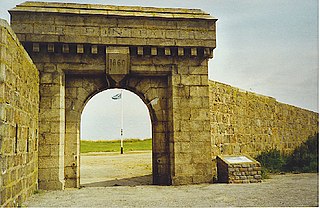
The Torry Battery is an artillery battery near Torry in Aberdeen, Scotland, which has overlooked the city's harbour since 1860. It was originally constructed for nine guns with a defensible barracks at the rear. In 1881 the battery mounted three 10-inch Smooth bore guns and five 68-Pounder Smooth bore guns.

HMS Abercrombie was a Royal Navy Roberts class monitor of the Second World War. She was the second monitor to be named after General Sir Ralph Abercrombie.

Jaime I was the third and final member of the España class of dreadnought battleships of the Spanish Navy. She had two sister ships, España and Alfonso XIII. Jaime I was built by the SECN shipyard; she was laid down in February 1912, launched in September 1914, and completed in December 1921. She was armed with a main battery of eight 12-inch (305 mm) guns and could steam at a speed of 19.5 knots.

Milecastle 0 is a possible milecastle of the Roman Hadrian's Wall which may have preexisted the fort of Segedunum. Although its existence has been suggested by historian Peter Hill, no evidence of this milecastle has been found. It is not known whether the decision to establish forts on the line of the wall predated the decision to extend the wall to Wallsend, so it is possible that this milecastle was never built.
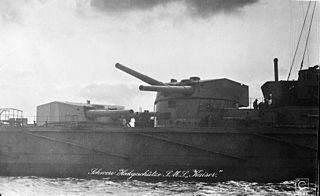
The 30.5 cm SK L/50 gun was a heavy German gun mounted on 16 of the 26 German capital ships built shortly before World War I. Designed in 1908, it fired a shell slightly greater than 12 inches in diameter and entered service in 1911 when the four Helgoland-class battleships carrying it were commissioned into the High Seas Fleet.

Cliff End Battery is a battery on the west coast of the Isle of Wight overlooking Fort Albert. It is one of the many Palmerston Forts built on the island to protect it in response to a perceived French invasion. Construction of the battery began in 1862 and was completed by 1868 at a cost of £32,714.
The Tyne Electrical Engineers (TEE) is a Volunteer unit of the British Army that has existed under various titles since 1860. It has been the parent unit for a large number of units fulfilling specialist coastal and air defence roles in the Royal Engineers (RE) and Royal Artillery (RA), many seeing service during both World Wars. TEE companies currently form part of the RE and of the Royal Electrical and Mechanical Engineers in the Army Reserve.
The 37th Searchlight Regiment, Royal Artillery was an air defence unit of Britain's Territorial Army (TA) during World War II. It served in the Battle of France, when it was one of the last British units evacuated. It then served in Anti-Aircraft Command defending the UK, particularly against V-1 flying bombs.

The Moonlight Batteries were Searchlight units of Britain's Royal Artillery that specialised in providing 'artificial moonlight', otherwise known as 'movement light' or 'Monty's moonlight', for ground operations during the latter stages of World War II.


